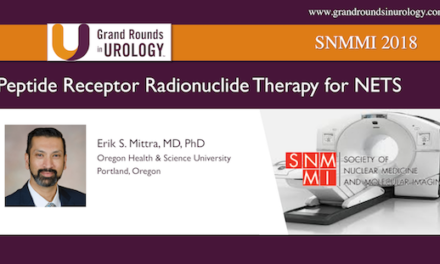Dr. Phillip J. Koo, MD, presented “Therapeutic Radiopharmaceuticals and the Emergence of Theranostics” at the 26th Annual Perspectives in Urology: Point-Counterpoint, November 12, 2017 in Scottsdale, AZ
How to cite: Koo, Phillip J. “Therapeuctic Radiopharmaceuticals and the Emergence of Theranostics” November 12, 2017. Accessed Jan 2025. https://dev.grandroundsinurology.com/therapeuctic-radiopharmaceuticals-emergence-of-theranostics/
Summary:
Dr. Phillip J. Koo discusses the use of radiopharmaceuticals in prostate cancer treatment, as well as the area of theranostics. He goes into detail on the process of choosing these radiopharmaceuticals and trying to determine the best ones to use in various situations in regards to prostate cancer.
Therapeutic Radiopharmaceuticals and the Emergence of Theranostics
Transcript:
Great. Thank you, Dave. I always enjoy coming to Dave’s meetings because we sort of get caught up in the state-of-the-art, and I learn a lot about prostate cancer. We also get a little bit of what’s coming down the pipe, and sort of what’s going to be in the future. And I think this is one of those areas that is here today, and I think is going to play a bigger role in the management of prostate cancer in the years to come.
All right, So, we’re going to talk about radiopharmaceuticals in the therapeutic sense, and I think to me it’s sort of, it’s systemic, so it’s sort of a mixture of chemotherapy and radiation oncology. When we think about radiation oncology mostly it’s targeted radiation. And when we think about chemo it’s systemic. So, this is sort of systemic radiation. And it really works because we rely on this idea of the Tracer principle. And according to the European Nuclear Society it’s a radioactive, biologically active substance which is chosen in such a way that its spatial and temporal distribution in the body reflects a particular body function or metabolism. Because once we inject one of these radiopharmaceuticals we really lose control. So, we need to be able to pick it or direct it upfront to make sure it does what we want it to do.
This is now new. You know? We’ve been doing this for years, and that’s why I sort of think it’s sort of this idea that’s Back to the Future. But we’re doing it and we will be doing it much better.
Why did I put this up? Now I remember. It’s game-changing. Right? Michael Jordan in his heyday he changed the way basketball was played. Steph Curry, I mean look at this guy. How tall is he and how much does he weigh? But the NBA has literally changed because of Steph Curry, and now it will never be the same because our youth are now focusing only on their outside shots, they’re not posting up anymore, they’re shooting from half-court thinking they’re going to be the next Steph Curry. In reality, I think it’s going to continue to go in that direction because again, these leaders change the way the game is played. And I think that’s what’s happening right now.
The problem is we have a lot of baggage when it comes to radiopharmaceuticals, and we’ve got to let go of this baggage. And I will be the first one to say that strontium, samarium, and these other things that we are talking about were terrible. And that’s why I don’t even like talking about them anymore because we’ve moved on past it, and even in my career I can’t remember the last time I gave a samarium or strontium injection. It’s just not part of our practice.
All right, so there’s two big areas that I want to talk about. I want to talk about targeted alpha therapies and theranostics.
So, the first one we’re going to talk about is radium-223, which is an alpha particle. It mimics calcium, so on the periodic table it falls in that same column, 2+ column with calcium. So, it’s a calcium mimetic. It localizes to bone, and it localizes bone to a greater degree because when you have a prostate cancer cell there you have greater surface area of bone. So, based on that, you’re going to get more localization in that radiopharmaceutical. And also, you’re going to get increased blood flow, and that’s also going to help localize the radium to these bony metastatic sites. And then once it localizes there, it gives off its radiation, and it creates these double-stranded breaks that kills the cells and hopefully the cell can repair.
There’s new data published within the past year that talks about radium-223 actually disrupting the microenvironment in small animals in the bones, making it more inhospitable, I’ve always got to be careful with my negatives, for other bone mets to set up shop there. So, I think we’re learning more about this, and that sort of is something that we hypothesize, but I think we see more data with regards to that.
This is the biggest difference between what we’ve done in the past and what we’re doing today with alpha therapies. Alpha therapies have a relative particle mass of 7,000 versus 1 for a beta particle. Strontium and samarium were all based on beta particles. So, that’s 7,000 to 1. That’s like being punched by a super heavyweight versus the lightest featherweight or bantamweight around. So, that’s a huge difference.
But on top of that, this alpha particle actually only travels a fraction of the distance that a beta particle travels. So, once this alpha particle localizes to one of these bony sites it will only travel a short distance, and that’s the active range. It’s very close to where it lands. And it’s in an order of micrometers.
A beta particle, however, localizes and gives off radiation that could damage cells in a much larger area, and that’s why we see, that’s why we see that this is much safer than the therapies we’ve given in the past.
So, this is an advantage on both ends. It packs a more powerful bunch, and it damages less normal cells than what we’ve used in the past. It’s a win-win.
And what we’ve seen is it improves overall survival. We’ve never seen this with any of our radiopharmaceuticals in prostate cancer. Samarium and strontium were about bone palliation, improving bone pain. They’ve never improved overall survival. That’s why I don’t like to talk about these drugs in the same breath because they’re completely different, and their effects are completely different.
So, that’s sort of the beginning, and I think that’s the stage we’re in today. And we’ll talk about sort of how you use radium in my last talk.
Here is where we’re headed, this idea of theranostics. It’s the merging of drug therapy and diagnostics to advance personalized medicine. It’s combining a targeted therapy with a companion diagnostic. This isn’t new. We’re doing this, we’ve done this for decades with thyroid cancer therapies. Right? We would give someone iodine to confirm that their cells were still iodine avid, and if they were we’d give them I-131. They’d take a pill. It would treat the disease. So, we’ve done things like this, but we’re just doing it on another level, and it’s very exciting because not in prostate cancer but we have FDA approval, will have FDA approval for one of these drugs, which we’ll talk about.
So, the idea is you identify a target on the cell that’s specific for that cell. You create a binding molecule that is specific for that target. Once you inject the radiopharmaceutical that binding molecule is going to direct it only to those cells. Then with the linking molecule we could attach a variety of radioisotopes to that end based on what we need. If we need something to help us image and diagnose disease we put a beta emitter or a gamma emitter on it, like gallium-68. If we wanted to treat disease then we’d put on either a beta particle or an alpha particle that can create a therapeutic response, whether it’s a thorium, actinium, or lutetium-177. We could, there’s a whole bunch of these, but again, it’s just using the isotopes to create what effect that we want.
So, it really leads to this idea of personalized medicine. So, you’re going to have a group of patients who are out there, and some of them might be expressing a certain receptor, a certain antigen, some won’t, but we could perform a diagnostic test on these patients and then sort of separate them into two groups; one group that expresses it and one group that doesn’t. And those that express that antigen or that receptor they’re primed to receive a certain therapy and get a desired effect from that therapy. So, that’s the idea with theranostics.
So, this is an example of an FDG PET CT in a patient with advanced prostate cancer, and you see various sites of disease lighting up. But when you did a gallium-68 PSMA scan on this patient those sites did not light up. Right? So, this would tell us right up front that this patient would not be the ideal patient to receive a lutetium-177 PSMA therapy. And it’s not always black and white I think. We’ll talk about that a little further.
So, we’re going to first talk about lutetium-177 PSMA. The lutetium-177 isotope that we attach to that PSMA it’s a beta emitter and a gamma emitter and it has a half-life of roughly seven days. That’s important because the beta emitter is what is going to do the cell killing, and the gamma emitter is what’s going to allow us to image some of these patients.
How do we select these radiopharmaceuticals? It’s all based on the properties, and it says here the ideal radionucleotide for targeted therapy is persistent, short-range, and powerful. So, you want to pick something that’s short range because you don’t want it to hit non-target cells, and you want it to be powerful. So, if you look at this, you know, a lot of what we’re doing right now with lutetium because it has a nice half-life and it packs some power, but its range is relatively short. One of the radiopharmaceuticals that we use a lot for liver disease, patients with metastatic colon cancer, or patients with metastatic neuroendocrine disease, or HCC is Y90. That has a shorter half-life, packs a powerful punch, but its range is actually very broad. It’s 12 mm, 1.2 cm. But if you think about how we deliver the Y90 it’s very targeted. That’s when it’s giving an IR into a hepatic artery, specifically so it only localizes to the liver. So, the idea of non-target radiation isn’t as big a deal. You wouldn’t be injecting Y90 systemically, because again it would create a lot of damage to normal tissues.
This is an example of a case published in the Journal of Nuclear Medicine last year performed in Germany. So, a patient with prostate cancer, they did a gallium-68 PSMA scan, and the PSA level was 387, and you could see sites of disease throughout the bones, the soft tissues. I mean pretty impressive.
Then they did, so this confirmed that this patient had the PSMA antigen, and would be eligible to undergo lutetium-177 PSMA therapy. So, they gave the first dose of PSMA, and they could actually image that patient because they could image the gamma emitter. And what you see is that the image quality isn’t as good. Right? This looks a little fuzzier, but that’s fine. But it confirms that the lutetium-177 PSMA went to the same sites that the gallium-68 PSMA went to. So, that’s great. It’s almost this internal quality control piece that we have.
The patient returns two months later, PSA drops to 9.21 and look at all of those sites of disease. They’re kind of disappearing. Right? And this was given in four cycles. The patient returns again in two months. Those sites of disease continue to disappear. PSA goes down to 1.96. And then in June of 2015 those sites are gone, and the PSA now is 1.1. I mean this is pretty impressive. It reminds me of a lot of the lymphoma scans that we do in PET CT where the disease just melts away. All right, but it’s just a small patient, just an example, but this was the PSA response. You get a lot of patients where their PSA went down, but you actually had some patients where their PSA rose, and I think what we’re seeing here is maybe we’re not picking the right patients.
So, when we talk about theranostics and being able to divide patients into the responders versus nonresponders it’s not so black and white. We actually have to, we know that prostate cancer is heterogeneous, and Dr. Bryce has talked a lot about that. So, it’s really a matter of how much PSMA they are expressing and how much are they not expressing. And we know that 5 to 10% of those prostate cancer patients don’t express the PSMA. So, if we could find that ideal threshold above which they would be a good candidate for these drugs we could administer these and have a greater effect.
These are just the various small retrospective trials, all done in Europe and outside the U.S. that have shown some efficacy with this lutetium-177 PSMA. The response rates with regards to 50% PSA response I think are around 30 to 70%.
So then we’re going to move onto targeted alpha therapies, and this is an area that I think will come after lutetium-177 PSMA. And the two major alpha particles are going to be actinium and thorium, with a 10-day half-life and 19-day half-life.
The reason why this idea is very good is because the alpha particles have the highest amount of power and the shortest range. So, the question when we’re doing these therapies with alpha particles is we know it’s going to be effective in terms of the killing the cells, but is it going to kill too many normal cells? And that’s what we need to be sure of because PSMA will be expressed in your kidneys, your salivary glands. And if we start giving this and people get sialadenitis, and dry mouth, xerostomia, or whatnot, those are serious things we need to deal with. If they get renal failure, again that’s not something we could afford.
And this just comes from one of the, a website that talks about thorium. The same idea; you take an alpha particle, you chelate it to a monoclonal antibody, you inject it, it circulates, and because it has that monoclonal antibody that’s directed towards PSMA it will localize in those prostate cancer metastases or whatnot.
This comes from the Journal of Nuclear Medicine 2016, using actinium in a patient with prostate cancer. So, this is a gallium-68 PSMA scan, again you see disease everywhere. The patient undergoes three cycles with actinium PSMA and look at that response, a PSA of 2,923 to a PSA of .26, and the disease just melted away. And they gave one more cycle for consolidation, and the PSA went to less than 0.1. I mean this is very encouraging. But again, very early, and we still have a lot more to learn. But I think this is creating a lot of excitement from pharmaceutical companies as well about the future of theranostics.
This is just to sort of review the different classes of drugs that we have for advanced prostate cancer. You have the AR inhibitors that Dr. Bryce talked about. You have the targeted alpha therapies. These are all available currently right now. You have the chemotherapies, the immunotherapies, and the supportive therapies. Take note that strontium and samarium are not in the targeted alpha therapy category. They are in the supportive therapy category, completely different from what we have with radium-223. And down the pike we have the PSMA with thorium, actinium, lutetium-177. So, I think it’s a very exciting time.
Oh, take-home points. I don’t think this is a fad. Granted things, a lot of the things come and a lot of things go, and granted I’m biased, but I really think something like this is something that will hold some weight, and I think will just change how we take care of patients. I think it’s important for us to be prepared and figure out ways we can work with this, but I think we have a very good starting point with the radium-223 to sort of incorporate this into our practices now.
ABOUT THE AUTHOR
Phillip J. Koo, MD, is the Division Chief of Diagnostic Imaging and Northwest Region Oncology Physician Executive at the Banner MD Anderson Cancer Center in Phoenix, Arizona. Prior to this, he was Chief of Nuclear Medicine and Associate Professor of Radiology at the University of Colorado School of Medicine. Dr. Koo completed his transitional internship at the University of Pennsylvania Medical Center-Presbyterian, his radiology residency at Pennsylvania Hospital of the University of Pennsylvania Health System, and his fellowship at the Harvard Medical School Joint Program in Nuclear Medicine. He is a diplomate of both the American Board of Radiology and the American Board of Nuclear Medicine. Dr. Koo is an active member of multiple societies and has served as the Chair of Nuclear Medicine for the RSNA Scientific Program Committee, Chair of the Quality and Evidence Committee for the Society of Nuclear Medicine and Molecular Imaging (SNMMI), and Chair of the Prostate Cancer Working Group at the SNMMI. Dr. Koo has published on various topics related to radiology and nuclear medicine in multiple journals such as Radiology, Radiographics, the European Journal of Nuclear Medicine and Molecular Imaging, Urology, and the Journal of the American College of Radiology.





